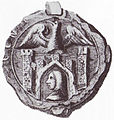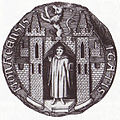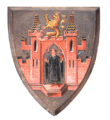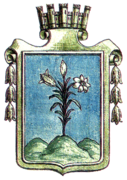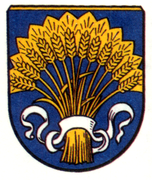Coat of arms of the state capital Munich
|
Munich Free State of Bavaria |
|
|---|---|
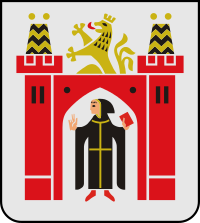
|
|
| Blazon | |
|
|
| City colors | |
| Black gold | |
| Basic data | |
| Introduction: | 1239, kl. Seal: 1304 |
| Legal basis: | Seal guide: 1239, city council resolution: 1957, |
| Supporting documents: | June 11, 1865: Royal approval, December 24, 1936: Ministerial resolution, December 17, 1957: City council resolution |
| Changes: | 1808, 1818, 1834, 1865, 1936, 1949 |
| Former municipalities with their own coat of arms: |
Au , Aubing , Feldmoching , Obermenzing , Pasing , Schwabing , Untermenzing |
The coat of arms of the state capital Munich has been used since the 13th century and has been changed many times over the course of Munich's history . Today's representations of the large and small city arms have been in effect since 1957. Except for the short period from 1808 to 1818, an essential part of the arms was always a monk , as the name of the city of Munich is generally derived from Mönch. The monk figure is often referred to as the Münchner Kindl .
The large and small city coat of arms in its current form was designed in 1957 by the graphic artist Eduard Ege , whereby the large coat of arms is no longer intended for general official use, but only for special representative purposes as a national emblem .
The monk
The coat of arms with the monk is a talking coat of arms and refers to the name of the city, which was mentioned as "Munichen" when it was first mentioned in 1158 . "Munich" is the Old High German name for monk.
The monk is depicted with a gold bordered, black robe, as well as with a hood and red shoes. He is holding a red book in his left hand, the right is raised, thumb, index and middle fingers are outstretched. The official interpretation, which is given in the city arms statute, sees the right hand raised to the oath, the red book in the left hand should accordingly be the oath book of the city or the city law book, which has been handed down as a red bound manuscript from 1365. This interpretation is based on some Munich city historians of the 19th and 20th centuries. Based on the sources in the city archive, Helmuth Stahleder sees this interpretation as a mistake of the 19th century and refers to the Christian tradition of the city, according to which the outstretched hand is to be interpreted as a gesture of blessing and the red book as a book of the Gospels .
The monk as the sole heraldic figure can already be found on a seal from 1304 and on the city's flags since the middle of the 14th century. In the course of a few centuries until the current version from 1957, this has undergone clearly visible changes. While the monk had already taken on somewhat childish traits in the 15th century, in the 18th and especially in the 19th century the monk was increasingly belittled as a Munich child . This designation is documented for the first time in 1727.
history
Medieval city seals
The coat of arms of Munich can already be proven by city seals from the years 1239 and 1268. These show a hooded monk's head in a crenellated gate and an eagle above the gate. The third Munich city seal, which was used from 1304, resembled the small city coat of arms that still exists today and showed a simple standing monk figure with a raised right hand and a book in his left hand. City seals that resembled the Great City Coat of Arms that still exist today have been used since 1323. A monk fully depicted stands in the archway, and instead of the eagle depicted earlier, a lion rises above the gate. The Golden Lion is since the investiture of the Duke Louis I, Duke of Bavaria in 1214 with the Rhine Palatinate a symbol old Bavarian and Palatine Wittelsbach.
Coat of arms after confirmation by Max I. Joseph
In 1808, King Max I Joseph gave the city of Munich a historicizing city coat of arms with an ancient portal on which the royal crown lies. Sitting in the gate is the golden lion , holding a sword and a shield with the letter “M” in his paws. As an enlightened monarch, Max I. Joseph wanted to set an example and put an end to "monk barbarism" in the coat of arms. The town's citizens protested, however, against the complete erasure of this historical reference, and so in 1818 the M in the coat of arms was replaced by the monk's head.
Coat of arms after confirmation by Ludwig I.
King Ludwig I gave the city its old coat of arms again in 1834 in the form of large and small coats of arms. These reproduced the old seals in their representation, the small coat of arms the seal of 1304, the large coat of arms that of 1323. The coat of arms from 1835 contained blue as the field color, which was corrected by silver in 1865 under Ludwig II . Incidentally, the field color was rarely changed; For example, gold was used for this in the 16th century.
Coat of arms in the time of National Socialism
Only from 1936 to 1945 was the lion on the large coat of arms replaced by the eagle, the imperial eagle of the “Third Reich” with a swastika; the Münchner Kindl stood like a policeman with outspread arms in front of a gate; the design comes from Richard Klein . After this National Socialist version of the coat of arms was abolished after the Second World War , no official coat of arms was established from 1945 to 1948.
Newer coat of arms
From 1949 to 1957, both a small and a large coat of arms existed again. The representations as they were valid before 1936 were used.
In 1957, both the small and the large city arms were redesigned by the graphic artist Eduard Ege . At the same time, on December 17, 1957, the city council passed the resolution to no longer use the large coat of arms for official purposes, but only for special representative purposes.
The blazon and the representation published in the last valid city arms statute are valid. The city coat of arms statute of December 2, 2002 has been in effect since January 1, 2003. The official coats of arms do not correspond to the rules of classical heraldry . On the one hand, flesh color is used for the skin and brown for the hair, which is not provided for in classic heraldic art. On the other hand, the colors are not always clearly separated from each other, for example on the head and the hand. However, this is no longer decisive nowadays, since in the Middle Ages these rules were used to distinguish them on the battlefield, even over greater distances.
Coats of arms of Munich districts
→ List of coats of arms in Munich
Only a few of today's Munich districts had their own coat of arms before they were incorporated. In detail, these were the suburbs of Au , the cities of Pasing and Schwabing and the communities of Aubing , Feldmoching , Obermenzing and Untermenzing . The council of Milbertshofen , which had become a town in 1910, decided to introduce a coat of arms on February 16, 1911. However, this introduction was initially postponed due to the planned incorporation into Munich ; the incorporation in 1913 made it obsolete.
literature
- K. Stadler: German coat of arms - Federal Republic of Germany. Angelsachsen Verlag 1964–1971. 8 volumes.
- Helmuth Stahleder : From Allach to Zamilapark . Names and basic historical data on the history of Munich and its incorporated suburbs. Ed .: City Archives Munich. Münchenverlag, Munich 2001, ISBN 3-934036-46-5 .
Web links
- The city coat of arms of the state capital Munich. In: muenchen.de - The official city portal. City of Munich, accessed February 7, 2011 .
- House of Bavarian History: coat of arms and coat of arms history
Individual evidence
- ↑ City arms statute of December 2, 2002, § 3 (2)
- ↑ City arms statute of December 2, 2002, § 3 (1)
- ↑ Stahleder, From Allach to Zamilapark, p. 78
- ↑ Statute of the City of Munich on the use of the city arms (City Arms Statute - STWS) of December 2, 2002, city council resolution of November 27, 2002, announcement on December 20, 2002 (MüABl. P. 703, PDF 73 KB)

